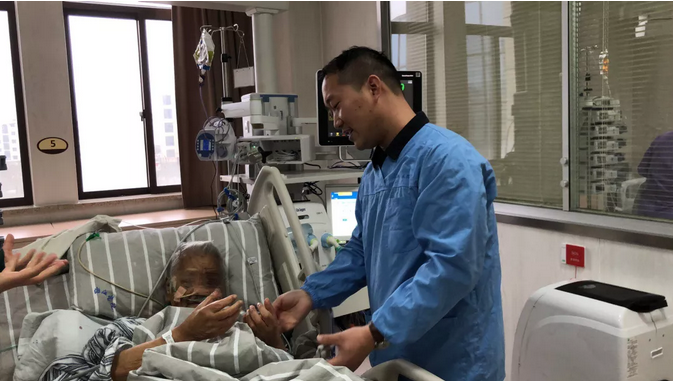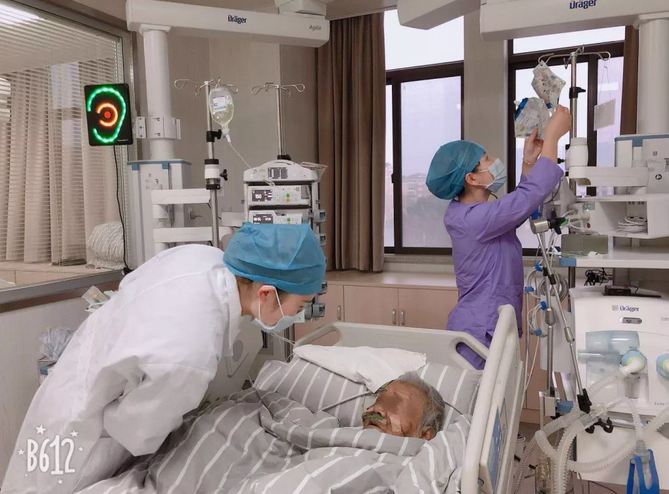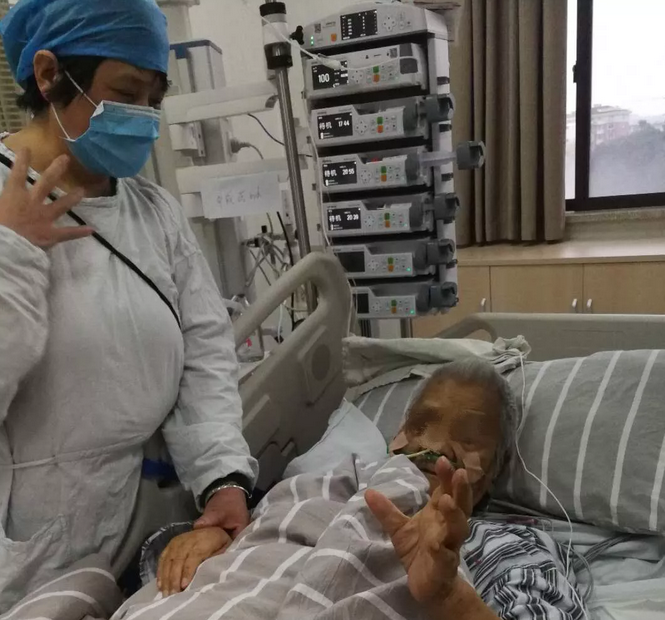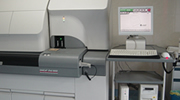The 99-Years-Old Accidentally Fell and was "unconscious" in the ICU for 27 days and was Recovered.
Hits: 3227 Time: 2019-02-18
|
|
" Thank you!” It's hard to imagine that the three words are coming from a 99-year-old lady who has been in a coma for more than half a month. Her family said: “We were all prepared for the worst. We did not expect that she would wake up!" Zhejiang Hospital is a miracle place ..." |
|
The 99-year-old lady had a brain haemorrhage when she fell unexpectedly.
Ms. Dong, 99 years old, but the body was still very strong. As usual, she often swept the floor, wash her clothes. On the evening of November 23 last year, she was hit by hemorrhage due to an accidental fall.
Her situation was extremely critical. Zhejiang Hospital Emergency Department immediately launched a green channel. Then she was done with emergency cranial brain CT examination. From the CT examination, we found that her brain haemorrhage area was very large, more than 60 ml. According to medical industry, if that area was greater than 30 ml, surgery should be performed immediately. However, considering the patient's age, coupled with a large amount of bleeding, if there was no cleaning up, re-bleeding will happen again. That will bring greater difficulty to surgery.
On November 27th, before the patient's brain function was impaired, the operation was carried out in time, and Dr. Shen zheng, director of neurosurgery at Zhejiang Hospital, performed a double-sided open skull decapitation valve hematoma removal procedure for Mrs.Dong, who was in a coma. Shen Zheng and his assistant were nervously busy in the operating room, while the elderly's family waited anxiously outside the operating room... According to Shen’s memory, that surgery was equipped with high difficulty due to the patient's age and her acute intracranial bleeding. That operation was not just simple drilling drainage. It needs to open both sides of the skull to remove the bone flap. Zhejiang hospital neurosurgery team with rich surgical experience had designed a personalized surgical program. With careful preoperative effective evaluation and reasonable anaesthetic management, they spent 4 hours of "blood fighting" in completing that operation. The bruising was successfully cleared. After the operation, Mrs. Dong was transferred to an intensive care bed (ICU).
Careful therapeutic care in the ICU.
Getting "Unconscious “for 27 days before miraculous awakening
Although the operation was completed, she had been in a state of drowsiness after surgery due to high age. Because of her poor preoperative nutrition, a series of complications was followed. Any kind of complications may be fatal to the elderly. The great pressure was once again on the doctors' shoulders.
Dr. Cai Guolong, Director of the Department of Critical Medicine of Zhejiang Hospital, said that Zhejiang Hospital Intensive Medicine Department had a reasonable postoperative management system. Since Mrs. Dong’s transferring to
the ICU, her vital signs management went first. These procedures included the postoperative blood pressure management and target temperature management, effective detection of patient heart rate and breathing, reviewing the cranial brain CT, paying attention to the color of drainage pipe drainage fluid and flow, paying close attention to the patient vital signs and changes in the state of consciousness.
Secondly, the ICU team help Mrs.Dong strictly guard against infection. Because the brain haemorrhage had led to some loss to the patient, the patient often was followed by the phenomenon that the sputum could not be out of your body after surgery. So, it was easy to make the patient breath with difficulty. It could be said that the chance of respiratory infection was 100%. Therefore, the respiratory management was also very important before Ms. Dong woke up. The ICU team had done effective airway maintenance for Mrs. Dong. Lin Juan, as nurse of Zhejiang Hospital Intensive Medicine Department, said: "Although I did not know when Dong grandmother could wake up, but we will not give up a little hope. Every day we help her complete oral cleaning and use a ventilator to help patients breathe."
Mrs. Dong seems to experience everyone's love and expectation. Her perception may be getting better day by day. "In the ICU, it is also very important to give patients early functional rehabilitation. When everyone expressed the disappointment, we still think there was a hope there. Although Mrs. Dong was unable to move in her hospital bed at ICU, we still performed physical rehabilitation activities for her, " said Dr. Hu Caibao, deputy director of the Department of Critical Medicine at Zhejiang Hospital. In addition, we also actively communicated with her family and finally we found her favorite opera to 'wake her up with the music'.
In addition, nutritional support for patients is also necessary. Health care providers used nipple sodium micropump injections to control the patient's blood pressure between 150 and 160.Afterwards, nutrients were injected from the nasal intubation to the stomach to enhance the body's immunity to infection and promote the recovery of brain cells.

"Miracle" finally arrived in. 27 days after the operation, Ms. Dong finally woke up. “When it came to her waking up, she could remember nothing and couldn’t move. However, after the ICU continued to treat and care after surgery, Mrs. Dong’s body and mind had returned to the previous state. Even paraplegia in the left limb caused by the accident had returned to its original state. "It feels good today! Mrs. Dong had a cordial exchange with the nurse at the bedside.
"Miracle was really for those who had already prepared. It was the
excellent postoperative management system of the critical medicine team of
Zhejiang Hospital, as well as the careful and warm treatment and care of medical
staff, that gave my mother a second life." Mrs. Dong's son said excitedly.

How should people with cerebral hemorrhage recover?
According to Cai Guolong, cerebral hemorrhage had a high disability rate. Patients had different degrees of residual problems, such as paraplegia, aphasia, swallowing difficulties, etc. It was suggested to timely seize the best opportunity for rehabilitation, do early intervention to utilize the rehabilitation training to help patients return to normal life.
1. Training for the daily life
When Patients' daily activities could not completed, such as eating, dressing, brushing, combing their hair, and going to the toilet etc., family members or rehabilitation physicians should assist patients to help them carry out normal daily activities.
2. Language training
Brain haemorrhage did harm to the brain language control area. Rehabilitation training was essential. We might do language training before testing the patient's language situation. Which language disorders were they? Through the stimulation of the ability of hearing, vision, touching etc, the patients’ correct language response will be triggered and strengthened.
3. Position placement
Keeping the patient's limbs on top, it was required to generally keep side-resting position, and change position.
4. Psychological adjustment
It needed a psychological adaptation process to deal with her physical condition at the process of body healing. As the recovery time of cerebral hemorrhage needed to take long time, patients should do a good job of long-term rehabilitation training. There would be some mood accompanied before and during the rehabilitation, such as, rehabilitation process, some impatience, discouragement, pessimistic mood etc. Her family and rehabilitation professionals were required to let patients correctly understand the importance of disease rehabilitation. More psychological guidance was suggested to let patients insist on rehabilitation treatment.
5. Physical training were divided into two. One was passive movement. The other was active movement.
As for passive movement: that will involve all the gently soothing joint activities including shoulder, hands, hips, and ankles, according to the principle of practicing from the near end to the far end, from small amount of activity to large one, from small range of activity to the large, avoid bringing any discomfort ,etc.
Regarding active movement: When the muscle strength of the patient's limb reached to a certain level, the patient takes the initiative to move or uses aids to carry out activities to restore the strength of the body, including bed turn training, sitting training, seat balance training, standing training, etc. Outdoor activities were available when the patient could leave the bed independently.






